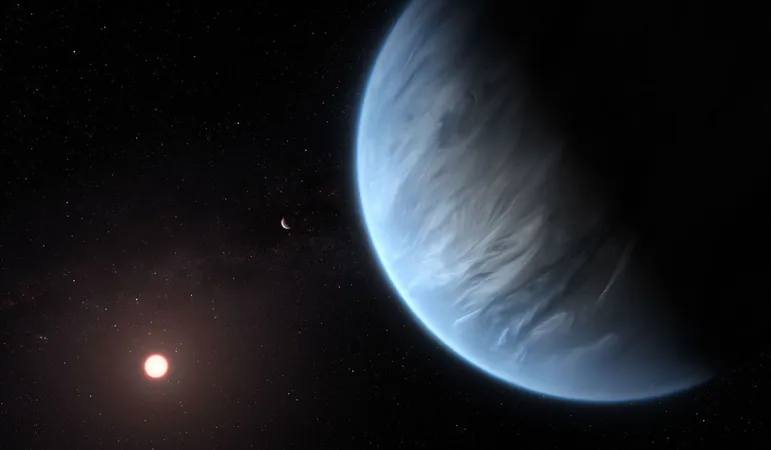
Are Our Hopes for Ocean-Covered Exoplanets Drying Up?
2025-09-22
Author: Ming
Sub-Neptunes: More Desert than Deep Sea?
Recent research has upended our understanding of sub-Neptune planets, once thought to be promising "water worlds." Instead, these enigmatic spheres might turn out to be parched desert landscapes rather than the aquatic paradises scientists envisioned.
For years, astronomers speculated that these planets, larger than Earth yet smaller than Neptune, could harvest ice from remote regions of their solar systems. As they drifted closer to their stars, the ice was thought to melt into vast, hidden oceans beneath thick hydrogen atmospheres.
The Shocking Revelation from Scientists!
Caroline Dorn, a physics assistant professor at ETH Zürich and co-author of the study, stated that their findings dismantle this long-held belief. "Our calculations show that this scenario is not possible," she revealed.
This revelation comes hot on the heels of tantalizing claims about K2-18b, an exoplanet about 124 light-years away. Earlier this year, researchers analyzing data from the James Webb Space Telescope hinted at the presence of dimethyl sulfide, a potential biomarker, suggesting this planet could be shrouded in a hydrogen-rich atmosphere enveloping a massive ocean—ideal conditions for life as we know it.
Reality Check: Scientific Pushback
However, these claims quickly faced skepticism. Independent reviews of the same JWST data determined that evidence for dimethyl sulfide was not robust. Experts cautioned against viewing sub-Neptunes as habitable worlds, suggesting instead that they might be volatile planets viciously wrapped in thick, inhospitable atmospheres.
A Deep Dive into Planetary Evolution
In their groundbreaking study, Dorn and her team closely examined how sub-Neptunes evolve during their formative stages, when they are cloaked in hydrogen gas and molten rock. Unlike previous models, they incorporated the intricate interactions between magma and the atmosphere.
Out of 248 simulated planets, the results were disheartening: "There are no distant worlds with massive layers of water making up around 50 percent of the planet's mass, as was previously thought," Dorn stated. Instead, Hycean worlds boasting 10-90 percent water are now deemed highly unlikely.
Less Water Than Initially Believed
The study revealed a startling trend: hydrogen and oxygen, the essential components of water, tend to bond with metals and silicates in a planet's interior, trapping water deep beneath the surface. What began as promising reservoirs of ice ultimately led to less than 1.5% of the planet's surface mass being water.
Aaron Werlen, another researcher from Dorn's team, emphasized, "The actual water that remains on the surface is limited to a few percent at most." Their findings suggest that the most water-rich atmospheres appear not on planets formed further from their stars but on those created closer in, where chemical reactions generate water from gases.
A Sobering Outlook for Astrobiology
The implications of this research are significant for the field of astrobiology. If Hycean planets are unlikely to exist, the most viable candidates for liquid water—and perhaps life—are likely to be smaller, rocky planets that resemble Earth more closely.
K2-18b: A Target Worth Investigating
Despite these sobering findings, scientists remain enthralled by K2-18b. As a sub-Neptune, it presents an intriguing opportunity to unravel the mysteries of planetary formation and evolution.
Ultimately, these discoveries suggest that Earth may not be as exceptional as we once believed. "In our study, it appears Earth is a typical planet," Dorn concluded, shaking the foundations of what many thought they knew about habitable worlds beyond our solar system.


 Brasil (PT)
Brasil (PT)
 Canada (EN)
Canada (EN)
 Chile (ES)
Chile (ES)
 Česko (CS)
Česko (CS)
 대한민국 (KO)
대한민국 (KO)
 España (ES)
España (ES)
 France (FR)
France (FR)
 Hong Kong (EN)
Hong Kong (EN)
 Italia (IT)
Italia (IT)
 日本 (JA)
日本 (JA)
 Magyarország (HU)
Magyarország (HU)
 Norge (NO)
Norge (NO)
 Polska (PL)
Polska (PL)
 Schweiz (DE)
Schweiz (DE)
 Singapore (EN)
Singapore (EN)
 Sverige (SV)
Sverige (SV)
 Suomi (FI)
Suomi (FI)
 Türkiye (TR)
Türkiye (TR)
 الإمارات العربية المتحدة (AR)
الإمارات العربية المتحدة (AR)